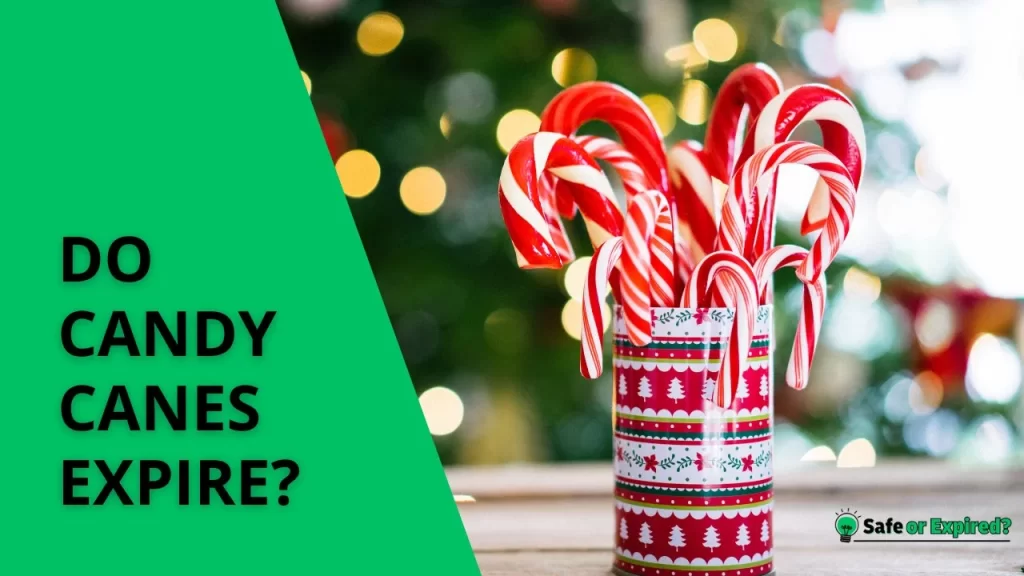“Do candy canes expire?” is our first thought whenever we find a stash of them after the holiday season. Well, the answer is the candy canes don’t have a strict expiry date, but they can still go bad.
But what will happen if you eat expired candy cane and can you increase its shelf life? In this blog, you’ll get answers to all of your queries.
Let’s start.
Do Candy Canes Expire? Here’s Everything You Need to Know
Candy canes do not have a strict expiration date, but they can lose flavor and become sticky over time. Still, you should take the expiry date on the box/package seriously. Canes can become soft after expiration and will not be tasteful.
But how long do candy canes expire? Well, it depends. The open ones are good to eat for up to a year. And how long do candy canes last unopened? Well, the unopened can stay good for up to five years. You might also wonder, “Do candy canes expire in the freezer?” Yes, they do.
Here’s a table about it:
| Storage Condition | Un-Opened | Opened |
| Counter | Up to five years in cool, dry conditions | A few weeks to a year in an airtight container |
| Fridge | Can Increase the shelf life | Not recommended. |
The Science Behind Candy Cane Preservation
The longevity of candy canes is rooted in the science of sugar’s preservative qualities. Sugar, the primary ingredient in candy canes, is a natural preservative that doesn’t let microorganisms grow. When candy canes are produced, the sugar is heated to high temperatures, creating an inhospitable environment to bacteria and mold.
This process, coupled with the low moisture content in candy canes, makes them less prone to spoilage. However, over time, sugar’s crystalline structure can absorb moisture from the air, making candy sticky and less enjoyable. So, eat the candy cane when you take it out of its packet.

Understanding this scientific basis helps take appropriate measures to maintain their quality over time.
How To Tell if a Candy Cane Is Expired? (Signs To Look For)
To tell if the candy canes are expired, look for the change in texture. Candies that absorb moisture may become sticky, soft, or clumpy. Visual changes are another telltale sign, including fading or bleeding of colors, which suggests they’ve been exposed to light or heat for hours.
Visual Signs of Spoilage
The most straightforward indicator of an expired candy cane is its appearance. Fresh candy canes are bright, glossy, and uniform in color. Over time, they may become dull and develop white spots or streaks. Moreover, if the vibrant stripes begin to bleed or fade, this also suggests that the candy canes are past their prime.
Texture Changes
Candy canes should be hard and brittle, easily snapping when bent. If you find that a candy cane bends without breaking or has become sticky, soft, or chewy, it’s a clear sign that moisture has infiltrated the packaging, leading to spoilage. These texture changes can affect the candy’s taste and overall quality.
Unusual Odors
While candy canes typically do not have a strong scent, any off-odors can be a telltale sign of spoilage. If you detect any unusual smells, particularly those that are musty or sour, the candy canes should not be consumed. This could indicate bacterial growth or that the candy has absorbed odors from its environment due to compromised packaging.
Taste Test
A small taste test can be the final judge if a candy cane passes the visual and textural inspection but you’re still unsure about its quality. Expired candy canes may taste stale. They don’t have a peppermint flavor or an unpleasant aftertaste. If the candy doesn’t taste right, it’s best to discard it.
Check the Packaging
Often, the state of the packaging can give clues about the candy’s condition. Candy canes still in their original, unopened packaging and stored correctly are less likely to expire.

Look for any signs of damage to the package, such as holes, tears, or excessive crinkling, which could have allowed air and moisture to affect the candy’s quality.
What Happens if You Eat Expired Candy Canes? (Main Risks)
Eating expired candy canes carries several risks, the biggest being food poisoning. The candies are contaminated by bacteria, which can cause stomach issues. Furthermore, eating spoiled candy canes can, in some cases, lead to dental problems.
Microbial Growth
One of the primary concerns with consuming expired candy canes is the potential for microbial growth. It usually happens due to improper storage conditions. Note that consuming candy that has been contaminated with bacteria, molds, or yeasts can result in food poisoning. In this, you will feel nausea, vomiting, and diarrhea symptoms.
Chemical Changes
Over time, chemical changes can occur in candy canes, especially if they are exposed to varying temperatures or direct sunlight. This can lead to the degradation of sugars and the development of off-flavors. While not necessarily harmful, these chemical changes can make the candy canes less pleasant to eat, potentially leading to indigestion or discomfort.
Allergen Development
Although rare, the breakdown of ingredients in expired candy canes could potentially lead to the formation of new allergens or the concentration of existing ones. Individuals with food sensitivities or allergies may find themselves at an increased risk of allergic reactions from consuming expired products.
Dental Risks
Due to moisture exposure, candy canes that have become sticky or softened over time can pose additional risks to dental health. Sticky candy adheres more readily to teeth, increasing the risk of gum diseases.
Furthermore, consuming candy canes that have changed texture may also pose a risk of dental damage, such as cracked teeth or fillings.
Psychological Discomfort
Consuming expired candy, especially if the taste or texture is off, can lead to psychological discomfort or aversion to the food. This is more of a comfort issue than a health risk. However, it’s still worth noting for those who are sensitive to changes in their food.
How To Store Candy Canes Properly? (3 Tips)
To store candy canes properly, keep them in a cool, dry place. Seal the candies in an airtight container to prevent moisture and odors from affecting them. You can also freeze them to increase their shelf life.
Store in a Cool, Dry Place
The key to prolonging the shelf life of candy canes is avoiding exposure to heat and sunlight. Heat can cause candy canes to warp, melt, or stick together, while sunlight can lead to fading of the vibrant colors that make candy canes so visually appealing.
A pantry, cupboard, or any storage area that remains consistently cool and is away from appliances that generate heat is ideal. People often ask, “Can I put candy canes in a refrigerator?” and the answer is yes, you can.
Use Airtight Containers
Airtight containers protect candy canes from humidity (which can lead to spoilage). When candy canes are exposed to air, they can absorb moisture, making them sticky and lead to sugar crystallization on the surface.
Sealing them in an airtight container creates a barrier against moisture and air, maintaining the candy’s quality and texture. Plastic containers with tight-sealing lids or resealable plastic bags are both excellent choices.
Keep Away from Strong Odors
Candy canes, primarily made of sugar, can easily absorb odors from their surroundings, altering their taste and making them less enjoyable to eat. This is particularly important if you store candy canes alongside strongly scented items like spices, coffee, or flavored teas in a pantry or storage area.
Side Note: For those curious about whether that box of cake mix in the back of your pantry is still viable for baking, check out another article I’ve written: “Can I Use an Expired Cake Mix?”
Conclusion
Candy canes do have a best-by date and can go bad. Here, I’ve explained their expiration date in detail. To revise important points, here’s a summary:
- Candy canes have a best-by date but can last longer if stored properly.
- Unopened candy canes generally last longer than opened ones.
- Check for signs of expiry, such as discoloration or changes in texture, before consumption.
- Store the candy canes in an airtight container and away from sunlight.
Remember that your festive treats can bring joy well beyond their season with the right care.

